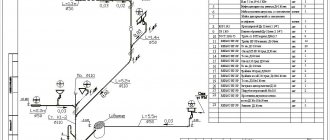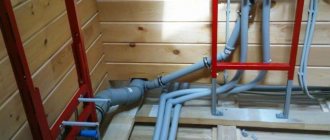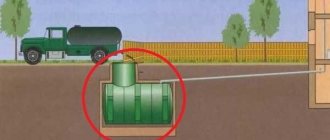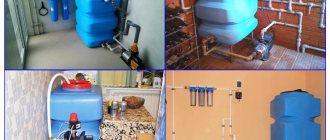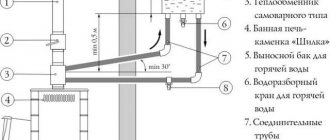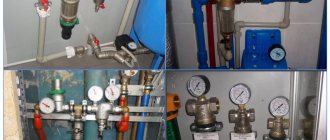SHARE ON SOCIAL NETWORKS
FacebookTwitterOkGoogle+PinterestVk
From this article you can learn the features of such a communications element as a sewer drain pipe: its purpose, types of existing products that can be purchased in stores, their characteristics and prices. The text describes the specifics of drains and recommendations for installing a sewer system riser, including instructions for dismantling the old pipeline.
Corrugated pipe for sewerage drainage
Selection of the optimal autonomous sewerage scheme
The problem of organizing household amenities can be solved in different ways. The easiest and cheapest is to buy a dry closet. A peat toilet is most suitable for a dacha, the processed waste from which can be dumped into a compost heap and subsequently used to fertilize the land.
The big advantage of such a device is that there is no need to supply water to it or organize drainage. But for a normal life, in addition to the toilet, other equipment is required (sink, shower, dishwasher, washing machine) that requires drainage.
Peat toilet in the country Source onlinetrade.ru
There are several options for where to drain dirty water from your home:
- cesspool;
- storage tank;
- overflow tanks with stepwise cleaning;
- septic tanks with biological treatment.
All of them can be used in the country, and the choice will depend not only on the amount that the owners are willing to spend on an autonomous sewage system, but also on many other significant factors.
Cesspool (shambo)
Essentially, a cesspool is a tank without a bottom into which wastewater is collected. The liquid seeps into the ground, and the rest accumulates in the hole. Such pits are either periodically cleaned with sewage removed to specially designated places, or when filled, they are buried and the drainage is removed to another place.
This design has only one advantage - low installation costs. There are many more disadvantages:
- Untreated wastewater penetrates the soil and pollutes it;
- periodically there is a smell of sewage in the air;
- the process of cleansing shambo is very unpleasant and labor-intensive;
- drainage to another location also requires effort, time and additional costs.
Cesspool - device diagram Source vodakanazer.ru
How to make a drain at the dacha with your own hands from the house into a cesspool can be seen in the diagram. To do this, the bottom of the dug pit is covered with filter material - crushed stone or gravel. Then the walls of the well are constructed from concrete rings with holes or sparse brickwork in the lower part. From the outside, the filter is again filled to the level where the solid walls begin. The remaining part is filled with soil, the tank is closed with a lid with a hole for the ventilation pipe.
It is important! Cesspools should absolutely not be installed in places with high groundwater levels, as well as on impermeable clay soils.
It is recommended to choose this method of arranging an autonomous sewage system in a dacha if it is not connected to a pressure water supply system and is used only in the warm season. Then the volume of the cesspool may be enough for a long time. Especially if the house is equipped with a dry toilet, and only liquid waste from the kitchen and summer shower flows into the pit.
To collect dirty water, a shambo with walls made of car or tractor tires is enough Source cstor.nn2.ru
Storage capacity
A universal option for wastewater disposal, suitable for use on any soil, is to collect it in a sealed storage container, followed by pumping and removal using sewage disposal equipment. Such a container can be installed at any level from the surface of the earth, including without being buried into it.
The advantages are the preservation of clean soil on the site and the absence of the risk of contamination of drinking water in wells and reservoirs. And also the low cost of construction when collecting wastewater by gravity. If the storage tank is mounted on the surface of the ground, the system is equipped with a drainage pump to pump dirty water into it.
This method of organizing drainage is not suitable for dachas with running water, a large number of plumbing fixtures and permanent residents, especially if the house is intended for year-round use. No matter how large the volume of the storage tank, it will have to be pumped out very often. Therefore, it, like a cesspool, is usually used in summer cottages or in “weekend” houses.
Plastic storage tank for sewage waste Source dacha.alltrades.ru
Storage tanks are made of plastic, metal, monolithic concrete and reinforced concrete rings. The last option is the cheapest, but to ensure tightness it is necessary to take care of the quality of the joint of the rings with each other and with the concrete bottom.
If the task is how to drain water from a house in the country as quickly as possible, the installation of a ready-made plastic container will take the least amount of time for arrangement. But you need to keep in mind that such products are very light, they need to be “anchored” - fixed to a concrete slab laid at the bottom of the pit so that the container is not pushed out of the ground by the forces of frost heaving of the soil.
A heavy reinforced concrete slab acts as an anchor Source eko-centr.ru
See also: Catalog of companies that specialize in the design and installation of sewerage and water supply
Overflow septic tank
The design consists of several containers or one divided into compartments. They are connected to each other by overflow pipes. The first container (or compartment) is a sealed receiving sump into which sewage from the house flows. In it, they are separated into a silty fraction that settles to the bottom and a clarified liquid.
When the level of this liquid reaches the overflow pipe, it enters a second sealed container, in which the process continues, and almost clear water is poured into the last tank, equipped on the principle of a cesspool. It passes through the bottom filter, freeing itself from remaining impurities.
Overflow septic tank with natural cleaning Source ultracomp.ru
Instead of a filter well, drainage channels or filtration fields are often installed to increase the area of absorption of purified water into the ground.
This method of cleaning allows you not to pollute the soil and pump out using sewage equipment much less frequently. This means that it is suitable for dachas with permanent residence and a number of residents of more than 4 people.
However, when the groundwater level is high, its implementation faces a big problem: wastewater from the last tank cannot seep into the water-saturated soil. Quite the opposite: groundwater can fill a well and mix with it.
In such cases, it is necessary to place filter structures on the surface of the earth or in a small depth, and supply the clarified liquid from the septic tank into them with a drainage pump. This makes the system energy-dependent and requires more funds for its installation and maintenance.
3-section septic tank with filter mound and drainage pump Source septikmb.ru
Biochemical treatment stations
When deciding how to drain water at their dacha, few people choose to install biochemical treatment stations because of their high cost and the need to preserve them for the winter.
These are energy-dependent multi-stage wastewater treatment systems, consisting of several blocks: a settling tank, filters, compartments with aerobic and anaerobic bacteria that process organic matter. They are equipped with pumps, airlifts and other equipment.
The degree of wastewater purification reaches 98%, which allows not only to discharge purified water onto open ground or into a reservoir, but also to use it for irrigation, car washing, filling decorative reservoirs and artificial ponds with live fish.
At the same time, the stations require minimal maintenance and practically do not need to be cleaned with sewage equipment.
Scheme of an autonomous sewerage system with a biological treatment station Source 3agorod.ru
The possibility of installing a station is not affected by the type of soil, the level of groundwater, or the seasonality of operation. you just need to correctly determine its power, taking into account the volume of wastewater and the number of residents in the house. Also, the choice of model can be influenced by the topography of the site and the level of the discharge point - it determines whether the system will be gravity or forced.
Sewage system design
Digging a large barrel into the ground and leading the drain pipe from the kitchen sink into it by making a hole in the wall of the summer house is not a difficult task. Much larger problems have to be solved when, in addition to a sink, the house has a shower, toilet, washing machine and dishwasher, and you plan to live in it for a long time. In this case, it is not enough to know how to make a drain from a barrel at the dacha with your own hands. We need a project, preferably one that complies with sanitary and construction standards and is agreed upon with the sanitary and epidemiological authorities.
The simplest drain that guarantees the absence of unpleasant odors in the house Source blogspot.com
In addition, to install the system yourself, you will need to select suitable materials and study the technology for arranging an autonomous sewer system so that during operation you do not encounter disruptions in its operation.
Video description
For more information about choosing a location on a site to place a sewer system, watch the video:
Selection of materials
Before draining water from your dacha house with your own hands, you need to select materials for the internal and external networks, and decide on the type, volume and material of the septic tank.
The conditions under which drain pipes will be used differ radically depending on their location. In the house they do not experience any external load and are available for repair at any time, unlike those that are laid underground. Therefore, when choosing a pipe material for an external pipeline, you need to pay attention to:
- strength and ability to withstand soil pressure;
- durability;
- resistance to aggressive environments and corrosion.
Several types of pipes are suitable for external sewerage according to these parameters - plastic, cast iron, asbestos-cement. But the last two types are now being widely abandoned in favor of plastic ones for the simple reason that they are more difficult to install and quite quickly lose capacity due to the roughness of the internal walls, overgrown with silt deposits.
PVC sewer pipes are the best choice for arranging a country drain Source esp-57.ru
Gray pipes are not highly durable, but they are better able to withstand temperature changes and have good sound insulation. Therefore, they are used for internal wiring.
Orange products are intended for laying external highways. Due to the multilayer nature and greater thickness of the walls, they do not deform under the weight of the soil.
The standard parameters of such pipes and fittings make it easy to connect them to each other without installing special adapters from the internal to the external network.
As for the dimensions, the internal wiring is made with pipes with a diameter of 50 mm, and the external one with a diameter of 100 mm. Risers and outlets from the toilet must also have a diameter of 100 mm.
Calculating the volume of a septic tank is also easy: to do this, the number of people permanently residing at the dacha is multiplied by the daily water consumption rate, which is equal to 200 liters. The container must hold at least three days worth of waste. For example, if the number of residents is 4, then the volume of the septic tank must be at least 4x200x3 = 2.4 m3. It’s better to take it with a reserve in case your family grows or guests arrive.
Connecting elements
Types of fittings
When laying a socketless pipeline, various fitting connections are required:
- sweeps;
- tees and crosses;
- squares;
- bends;
- audits;
- adapters.
Squares are found in 15 degree increments, usually using angles of 45 degrees. It is not advisable to make 90 degree turns, as this increases the likelihood of blockages. They also try to install the bends not straight, but at 45 degrees, taking into account the possibility of cleaning through the hole in the plumbing fixture; the flow from the bend should enter along the flow in the main pipe. Revisions can be built into other fittings. The adapters are asymmetrical - the smaller hole should be higher when installed longitudinally.
All connecting elements have gasket seals that ensure tightness. They must exactly match the pipe diameter and fitting type.
Video description
What else to consider when determining the volume of a septic tank is described in the video:
Having calculated the required volume, it is easy to select a ready-made tank or biological treatment station in a store or from the manufacturer. If you decide to build a treatment facility from reinforced concrete rings, you will have to take up the calculations again. For them, you will need to know the height of the ring h and its internal diameter d. The volume of one ring is calculated by the formula:
V = πd2h / 4
After that, it remains to determine the required number of rings by dividing the volume of the septic tank by the resulting figure. If the result is fractional, it is rounded up.
Video description
Using technology will greatly simplify and speed up the process, but you can do without it - an example in this video:
Note! The size of the pit depends on the chosen method of wastewater disposal. For example, if it is a storage tank made of concrete rings, it must be made significantly larger than their outer diameter in order to be able to seal all joints from the outside.
When installing overflow tanks, each next one after the receiver is installed lower. They should be half a meter apart from each other. If the soil in the area is heaving, it is advisable to fill the space between adjacent wells with sand or crushed stone as a buffer to dampen soil movement.
The next stage is marking the places where drain pipes enter the septic tank and digging trenches for laying the pipe. They are made deeper than necessary, and then the bottom is filled with sand to the desired level, while simultaneously creating the required slope.
The pipe is inserted with its blank end into the septic tank, and the next element is inserted into its socket, having previously lubricated the sealing rubber with oil to facilitate joining. The inlet is immediately fixed in a stable position and sealed with a rubber collar or, in the case of a concrete septic tank, sealed with sealant and mortar.
Specificity and types of pumps for sewerage in an apartment for the kitchen
The sump pump looks like a plastic reservoir, similar to a toilet cistern. It has threaded holes that are used to connect pipes.
Sewage pump
Pump Internal Parts:
- engine;
- automatic starting device;
- chopper
The pump has a simple operating system. Water coming from household appliances or from the sink flows into a plastic tank. When the container is full, a switch equipped with a float is activated, which starts the motor and chopper blades, if present. The crushed debris along with water is forced through the filter system, and then, under pressure, enters the sewer system.
There are several types of sewage pumps for the kitchen, differing in purpose and characteristics:
- sanitary (simple devices under the sink);
- forced sewerage stations;
Kitchen sewer pump
- stationary.
Sanitary pumps are not capable of discharging hot water and most often do not have blades. Their operating temperature is only 35-40 ºС. For the kitchen, it is better to choose forced sewage stations that can handle large volumes of liquid, perfectly grind organic waste and have high power. Stationary devices are suitable for installation in a closet, however, they are rarely used in apartment conditions.
Installing a sewer pump at home
Installation of sediment under the sink is carried out in the following order:
- The drain pipe is disconnected from the sink.
- A mounting fastener is installed on the sink over the rubber gasket, which is included in the standard configuration of the pump.
- The body of the device is connected to the sink drain using polypropylene pipes.
- Using plastic pipes, a connection is formed between the outlet of the central sewer system and the pump housing.
- Connecting the device to the power supply.
Sewage pump in the bathroom
Note! It is not allowed to combine several pumps into one network.
Installation of a pressure pump is also possible in other places. For this, open areas of the room, niches or cabinets located under the sink can be used. In this case, you can choose an inclined or vertical position for placing the pipes, because the liquid will move by gravity.
Video description
How to lay a pipe in a trench with a slope, watch the video:
The assembled pipeline is once again checked for compliance with the level along the entire length, if necessary, sand is tamped under it. After connecting to the internal wiring, it is checked for leaks by letting water in and observing whether a leak appears. If everything is in order, the pipe is first covered with a layer of sand 30 cm high, and only then the trench is backfilled with soil.
Gravity sewerage laid at shallow depths in regions with harsh winters requires insulation. For this purpose, special shells are produced from polystyrene foam and polyurethane foam. But you can also use other insulating materials that are not afraid of moisture.
Laying a sewer pipe in a warm “shell” Source bastion96.rf
The upper part of the septic tank also needs to be protected from freezing by making an earthen embankment around the neck, located above ground level. An insulated double lid wouldn't hurt either.
No. 6. Copper and steel sewer pipes
Copper and steel pipes can be called ideal in terms of durability , strength and corrosion resistance. They can withstand any temperature and pressure, are characterized by minimal thermal expansion, and have a smooth, non-overgrowing inner surface.
The main disadvantage is the high price. In addition, copper pipes require specific installation, which only a professional can handle.
It is justified to use such an extravagant version of sewer pipes when open installation is carried out, and plastic pipes will look ridiculous. Copper pipes are often used when creating a retro interior with a claw-foot bathtub.
Briefly about the main thing
Before draining water at your dacha with your own hands, you need to decide which method of waste disposal is optimal in your case. The easiest way is to dig a cesspool or install a storage tank, but these options are not the best, especially if the dacha is used all year round by a family of more than 2-3 people. Multi-chamber septic tanks with natural or biochemical treatment are much more reliable and convenient. They will require more investments, but they will serve for a long time and reliably under one condition: if all calculations are made correctly, and the system is installed with high quality and in compliance with all requirements.
Ratings 0
No. 1. Material of internal sewer pipes
Internal sewerage can be done using the following pipes:
- cast iron. Previously they were installed everywhere, but today they are practically not used;
- polyvinyl chloride (PVC);
- polypropylene. Looking ahead, we note that this is the most optimal option;
- polyethylene. Infrequently used;
- steel and copper. Expensive pipes that are not used, but are sometimes still used due to their appearance.
Despite the fact that polypropylene and PVC pipes are most widespread, when choosing, do not rush to immediately discard the other options, since in some cases cast iron and even copper pipes may be useful.
